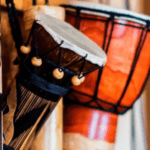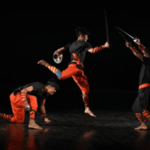Thang Ta: The Dance of the Sword—Where Combat Becomes Art in Manipur’s Cultural Heart
- indigenousartsfoundation
- September 29, 2024

i
n the mist-clad valleys and rugged hills of Manipur, an age-old tradition thrives—a martial art so poetic, it turns combat into dance. Welcome to the world of Thang Ta, a mesmerizing mix of strength, agility, and cultural pride. This is not just a battle of warriors but a spiritual performance where swordplay meets grace and footwork flows like water. Thang Ta, literally meaning ‘sword and spear,’ is more than a martial art; it’s a living testament to the history, valor, and rhythm of the Manipuri people.
- Art Meets Combat: The Techniques and Symbolism of Thang-Ta
What truly sets Thang Ta apart is its balance of elegance and ferocity. The weaponry—swords, spears, and shields—are wielded with such precision that each movement feels like a well-choreographed piece of theatre. Every flick of the wrist, every shift in posture, serves a dual purpose: it’s both a deadly strike and a poetic expression.
The rhythmic footwork, known as Ta, isn’t just about movement—it’s storytelling through dance. Imagine the swift clash of swords, followed by an elegant twirl of the spear. The body remains fluid, yet every action speaks of power. This combination of delicate choreography and martial precision is what makes Thang Ta a visual spectacle. It’s an art that captivates the soul as much as it displays mastery over physical form.
The performers use the sword (Thang) with such grace that you forget it’s a weapon designed for war. When paired with Manipuri traditional music, the strikes and spins form a mesmerizing dance that honors the legacy of ancient warriors while showcasing the rich cultural narrative of the region.
- More Than Martial: Spirituality and Deep Cultural Significance
For the Manipuri people, Thang Ta is not simply about entertainment or even historical preservation—it’s about spiritual connection. The dance is often performed during rituals and festivals, believed to invoke the blessings of deities and ancestors. Performers take on symbolic roles that embody the spirit of ancient warriors, invoking protection, guidance, and strength from the divine.
At its core, Thang Ta represents the Manipuri worldview, where war, spirituality, and culture are intertwined. The movements and gestures within the dance are believed to channel energy—an intricate link between the material and the spiritual worlds. The dancers, in their fluidity and strength, become mediums through which the past speaks to the present.
- Preserving a Legacy: The Importance of Thang Ta Today
As modern life evolves and the digital world pushes boundaries, many ancient traditions have faded into obscurity. Yet, Thang Ta remains alive and well, not as a relic of the past but as a living, breathing symbol of Manipur’s cultural identity. Schools and organizations across the state have worked tirelessly to preserve this tradition, teaching the next generation not just the techniques but the philosophy behind the art.
Performers today continue to mesmerize audiences at festivals, cultural events, and ceremonies, ensuring that this stunning art form doesn’t just survive, but thrives. Whether performed as a ritual or an art, Thang Ta is a vivid reminder of the strength, spirituality, and resilience that have always defined the people of Manipur.
“In every strike of the sword and every graceful turn of the body, Thang Ta whispers stories of warriors past and a culture still alive with spirit.”
- Thang Ta—A Living Legacy of Grace and Strength
Thang Ta is much more than just a fusion of martial arts and dance—it’s a window into Manipur’s rich cultural soul. With each performance, the spirit of ancient warriors lives on, their legacy intertwined with the very fabric of Manipuri life. As a living art form, Thang Ta continues to captivate, inspire, and connect people to their roots. Whether you see it as a dance or a battle, one thing remains clear: the power of Thang Ta lies in its ability to evoke emotion, embody strength, and celebrate the enduring traditions of Manipur.






